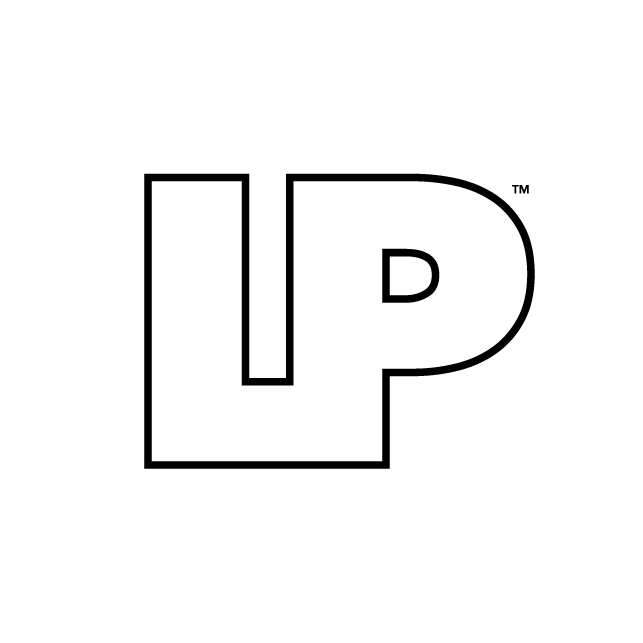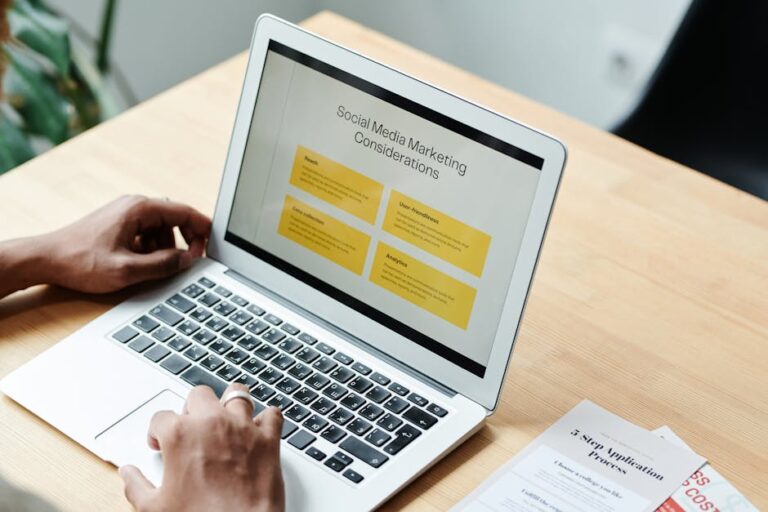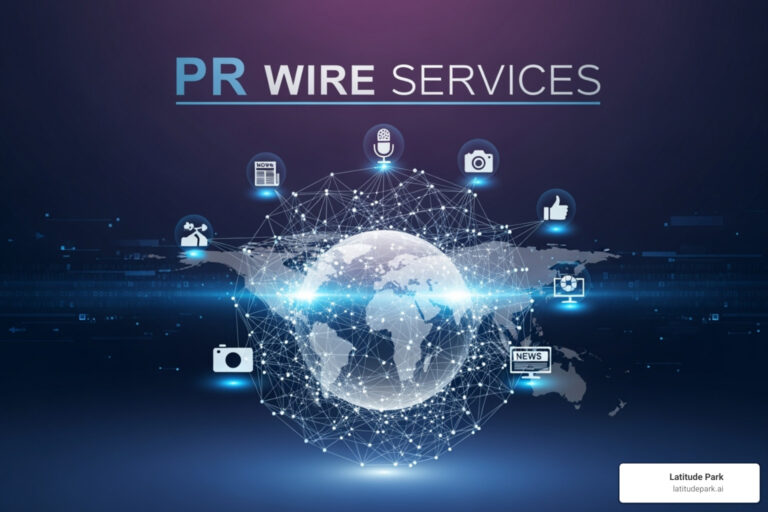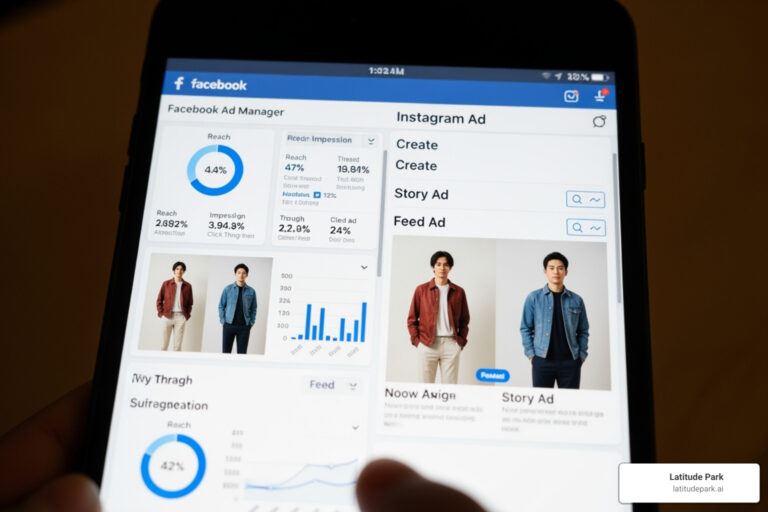Still wondering if Facebook ads are a smart move for your small business? Let me clear that up for you: absolutely. Especially if you rely on a local customer base, Facebook's targeting tools give you an edge you just can't get anywhere else.
Why Facebook Ads Still Win for Local Businesses
In a world overflowing with marketing options, Facebook advertising remains a cornerstone for small businesses that want to see real, tangible growth. The platform’s massive user base is one thing, but its true power is in its precision. You can connect with potential customers right in your own neighborhood, turning a modest ad spend into actual foot traffic and sales.
Picture a local bakery wanting to promote a weekend special on croissants. Instead of printing hundreds of flyers that mostly end up in the trash, they can run a geo-targeted ad. A practical insight here is to layer targeting. So, that ad gets shown only to people within a five-mile radius who’ve already shown an interest in things like "local food blogs," "coffee shops," or even followed a competitor's page.
That's the kind of detail that makes sure your message lands with the most receptive audience. The result? More customers walking through the door, a better return on your investment, and a direct line to the community you serve.
The Unmatched Power of Precision Targeting
The real game-changer for small businesses using Facebook ads is the ability to go way beyond broad demographics. You can build audiences based on specific behaviors, niche interests, and even major life events. Here are some practical examples:
- Interests: A local plant nursery can target users who like pages related to "organic gardening," "Monty Don," or "houseplant enthusiasts."
- Behaviors: A boutique hotel can reach people based on their online activities, such as "frequent travelers" or those who recently used a travel app.
- Demographics: A wedding photography business can target users with the life event status of "newly engaged" or those who have shown interest in "wedding planning" and "The Knot."
This granular control means you stop wasting money on people who will never become your customers. Every dollar is spent reaching individuals who are genuinely likely to be interested in what you're offering, giving even the smallest businesses a serious competitive advantage.
For a small business, Facebook Ads is like a digital megaphone pointed directly at your ideal customer. It cuts through all the noise and delivers your message to the people most likely to convert, whether they live down the street or share a unique passion.
And the data doesn't lie. By 2025, it's projected that over 68 million small businesses will be actively running ads on the platform. The average monthly spend is around $427—a 13% increase from the previous year.
This investment is clearly paying off. A full 1 in 3 small businesses report that their Facebook campaigns generate at least 50% of their online revenue. You can dig deeper into these Facebook ad statistics and their impact to see the full picture.
Navigating Your First Ad Campaign in Ads Manager
Jumping into the Facebook Ads Manager for the first time can feel like staring at a spaceship's control panel. All those buttons, dials, and settings can be intimidating, but trust me, launching your first campaign is way simpler than it looks. The secret is to ignore most of the noise and focus on a few key decisions that really move the needle, starting with a single, clear goal.
Forget the marketing jargon for a minute. When you create an ad campaign, you're just telling Facebook what you want to happen. Do you need more people to visit your website? That’s a Traffic objective. Want to get names and phone numbers from potential customers? You'll want the Leads objective. Picking the right one is easily the most important choice you'll make.
Let's make this real. Imagine a local dog groomer, "Pawsitively Clean," needs to book more appointments for the upcoming month. Their goal isn't just getting random clicks; they need actual contact info to follow up and schedule grooming sessions. For them, the Leads objective is a perfect fit.
Setting a Practical Budget and Schedule
After you've locked in your objective, the next question is always about money. You don't need a huge budget to get started. In fact, for most small businesses, a small daily budget is more than enough to start gathering some really valuable data.
Our groomer, Pawsitively Clean, has a good sense of their customers. They know that most people are thinking about booking appointments during the work week. So, they set up their campaign with a few smart parameters:
- Daily Budget: They decide on a modest $15 per day. This is enough to get their ad in front of a solid number of local pet owners without breaking the bank.
- Ad Schedule: They set the ad to run only on weekdays (Monday to Friday) from 8 AM to 6 PM. This move concentrates their entire budget on the exact times their ideal clients are most likely to act.
This "start small and be specific" approach is a cornerstone of many effective small business digital marketing tips. It lets you test the waters and see what works before you decide to scale things up.
Pro Tip: Don't let your ad budget run 24/7 if your business doesn't. Use ad scheduling to make sure your dollars are being spent when your customers are actually online and ready to engage.
Of course, before you can spend a dime, your account has to be set up correctly. This infographic lays out the simple, three-step process for getting your Facebook Business Manager ready to go.

Following this flow from the start helps you avoid the kind of technical headaches that can derail a campaign before it even launches.
Capturing Leads Directly on Facebook
For Pawsitively Clean, the last piece of the puzzle is figuring out how to collect that customer info. Sending people to an external website to fill out a form can be clunky and cause a lot of them to drop off. Instead, they use a Facebook Lead Form.
This is a game-changer.
When someone clicks the ad, the form opens right inside the Facebook app. It can even pre-fill information like the user's name and email directly from their profile, making it incredibly simple for them to hit submit. The groomer keeps their form short and sweet, asking for just three things:
- Name
- Phone Number
- Dog's Breed
By keeping the form dead simple, they boost the chances of someone actually completing it. This setup turns people scrolling through their feed into real, tangible leads that the business can call to book appointments, drawing a straight line from their ad spend to real-world revenue.
How to Find Your Perfect Customers on Facebook
The real magic of Facebook Ads isn't about blasting your message to the masses; it's about whispering it to the right people. Showing your ad to a thousand random users is just burning cash. But showing it to a hundred potential customers? That's a smart investment. This is where Facebook’s ridiculously powerful audience targeting tools become a small business owner's best friend.

Think of it as the difference between handing out flyers on a busy street corner versus personally inviting qualified leads to an exclusive event. Facebook lets you build audiences with stunning precision, making sure your ad spend is focused squarely on those most likely to pull out their wallets.
Let's break down the three fundamental audience types you'll be using.
Start with Core Audiences
This is your starting line, your foundation. Core Audiences let you build a profile of your ideal customer from the ground up, based on demographics, locations, interests, and even their behaviors. This is where you get to play detective.
Imagine you run a local shop selling handmade jewelry. Instead of targeting "everyone," you could build a Core Audience of:
- Location: Women aged 25-45 who live within a 25-mile radius of your city.
- Interests: People who have shown interest in pages related to 'Etsy,' 'handmade gifts,' 'artisanal jewelry,' and maybe even a few specific competitor brands.
- Behaviors: Users who have made online purchases in the past 30 days.
See the difference? This approach gets your ads in front of locals with a proven interest in your niche, which dramatically increases your odds of making a sale.
Your goal with Core Audiences isn't to be broad; it's to be brilliantly specific. The more you narrow down the characteristics of your ideal buyer, the more effective your ad spend will be.
Reconnect with Custom Audiences
While Core Audiences help you find new faces, Custom Audiences are all about reconnecting with people who already know your brand. Frankly, this is your most powerful tool for retargeting. These are warm leads who have already raised their hand in some way.
This feature lets you build lists from a few different goldmines:
- Customer List: Got a list of customer emails or phone numbers? You can upload it, and Facebook will match that data to user profiles. For example, a local chiropractor can upload their patient email list to show them ads for a new massage therapy service.
- Website Visitors: Once you install the Meta Pixel on your site, you can create an audience of everyone who has visited your website (or even specific pages, like an "abandoned cart" page) within the last 30 days.
- Facebook Engagement: You can also build an audience of people who have watched 75% of your video ad, liked your Page, or engaged with your posts in the past 90 days.
For a small business, a simple but killer strategy is to upload your email list and promote a new product exclusively to past customers. This builds loyalty and drives repeat business from your most valuable audience. When these ads work alongside your other marketing, like effective https://latitudepark.ai/seo-for-small-businesses/, you create a unified strategy that just works.
Find New Customers with Lookalike Audiences
What if you could clone your best customers? That's pretty much what Lookalike Audiences do. You give Facebook a "source" audience—like your list of best customers from a Custom Audience—and it analyzes their common traits to find brand-new people who share similar characteristics.
For example, a meal-kit delivery service could take a Custom Audience of their top 100 highest-spending customers, create a 1% Lookalike Audience from it, and let Facebook’s algorithm find thousands of new users in their country who have similar interests, buying habits, and demographics. This is hands-down the fastest way to scale your Facebook ads for small business efforts and find new customers who are eerily similar to your existing ones.
The platform's ability to do this is fueled by its massive user base of over 3 billion people. Research shows advertising on Facebook offers an 80% higher potential for users to discover new brands compared to just browsing retail websites. It's a massive opportunity just waiting for you to tap into. You can explore more about how small businesses can leverage Facebook's reach to grow their customer base.
Creating Ad Content That People Actually Click On
Your targeting can be perfect, but it's your ad creative—that magic combination of visuals, headlines, and copy—that actually stops the scroll. If your content doesn't grab someone's attention in the first three seconds, you’ve already lost.
The goal isn't just to be seen. It's to make someone pause, think, and ultimately, click.

This means you have to move beyond generic stock photos and bland, corporate-speak descriptions. I've found that the best-performing Facebook ads for small business often feel authentic, speak directly to a customer’s real-world problems, and create a genuine emotional connection.
Headlines and Copy That Actually Work
Think of your ad's text as your 30-second sales pitch. The headline is the very first thing people read, so it absolutely has to pack a punch. It should be benefit-driven, not just a dry description of what you sell.
Let’s take a dull ad for a local yoga studio and give it a makeover:
- Before: "Yoga Classes Available"
- This is passive and totally uninspiring. It just states a fact without creating any desire.
- After: "Find Your Calm: Join Our Sunrise Yoga Sessions in Downtown"
- See the difference? This version sells an outcome ("Find Your Calm") and provides enticing details ("Sunrise Yoga Sessions"). It’s an invitation, not a boring announcement.
The same principle applies to your main ad copy. Focus on the benefits, address a specific pain point your customer is feeling, and always, always end with a crystal-clear call-to-action (CTA).
The most effective ad copy doesn’t just describe what you sell; it illustrates the solution you provide. Speak to the customer’s problem first, then present your business as the clear and simple answer.
Why Authentic Visuals Win Every Time
In a feed flooded with polished, professional content, a little bit of authenticity really stands out. While slick, professional photos have their place, things like user-generated content (UGC) or even simple, real-life images can often perform much better. Why? They build trust and feel more like a recommendation from a friend than a corporate ad.
For example, a local coffee shop could run a campaign using photos their customers have tagged them in (with permission, of course!). An image of a real person smiling with their latte feels far more relatable than a sterile stock photo of a coffee cup sitting on a table.
This strategy is especially powerful with video, which now makes up around 40% of time spent on Facebook. A quick, behind-the-scenes video of your team hard at work or a short customer testimonial can drive incredible engagement. This is backed by data showing that ads on Facebook achieve an average conversion rate of 9.21%, making it a highly profitable platform when you get it right.
Choosing the Right Ad Format for Your Goal
With so many ad formats on Facebook, it can be tough to know where to start. The key is to match the format to your specific business goal. Here's a quick cheat sheet to help you decide.
| Ad Format | Best For | Pro Tip for Small Business |
|---|---|---|
| Image Ads | Driving traffic to your website, promoting a single product, or building brand awareness quickly. | Keep it simple. A high-quality image with a strong, benefit-focused headline is often all you need. Great for beginners. |
| Video Ads | Telling a story, demonstrating a product in action, or capturing attention with motion. | Short videos (under 15 seconds) perform best. Use captions, as most people watch with the sound off. |
| Carousel Ads | Showcasing multiple products, features, or telling a step-by-step story in a single ad. | Use each card to highlight a different benefit or feature. It's like a mini-landing page right in the ad. |
| Collection Ads | Creating an instant, mobile-first storefront experience. Perfect for e-commerce businesses. | Make your first video or image eye-catching to encourage people to tap and browse your full collection. |
Ultimately, the best format is the one that tells your story most effectively and gets your ideal customer to take action. Don't be afraid to test a couple of different formats to see what resonates.
A Simple Checklist for Ad Copy That Converts
When you're writing your next ad, run it through this quick checklist. Remember, great ad copy isn't just about being clever; it’s a critical piece of your overall content marketing strategy for your small business.
- Does it have a strong hook? The first sentence must grab their attention and make them want to read more.
- Does it highlight the main benefit? Be perfectly clear about what the customer gains from your product or service.
- Is the language simple and clear? Ditch the jargon and complex sentences. Write like you talk.
- Does it include a clear call-to-action? Tell them exactly what you want them to do next (e.g., "Shop Now," "Book Your Spot," "Learn More").
Making Sense of Your Ad Results and Improving Them
Launching your Facebook ad campaign is a huge first step, but the real work starts now. Understanding your results and making smart, data-driven adjustments is what separates a campaign that burns cash from one that builds your business.
Don't be intimidated by the numbers in Ads Manager; they're just telling you a story about what’s working and what isn’t.
Think of it this way: your initial ad is a hypothesis. The data you get back is the evidence that will prove or disprove it. The key is to know which pieces of evidence matter most. For most small businesses, you really only need to focus on a few core metrics to make intelligent decisions.
For example, your Click-Through Rate (CTR) tells you if your ad creative is compelling enough to make people stop scrolling and click. A low CTR often means your visual or headline isn't hitting the mark. On the other hand, your Cost Per Click (CPC) shows how efficiently you're buying that attention.
Troubleshooting a Common Scenario
Let’s walk through a practical example. Imagine an e-commerce store that sells beautiful, custom pet portraits. They launch a campaign and, after a week, see fantastic results in Ads Manager: a high CTR and a low CPC. People are definitely clicking! The problem? Almost no one is actually buying a portrait.
This is a classic—and fixable—dilemma. The ad is clearly doing its job of getting people interested, but something is breaking down after the click.
When your ad metrics look great but sales are flat, the problem usually isn't the ad itself. It's almost always an issue with the landing page or the user experience that follows.
The business owner needs to become a detective. Here's a simple troubleshooting checklist they can follow:
- Is the landing page a perfect match? The page users land on after clicking the ad must directly reflect the ad's promise. If the ad shows a golden retriever portrait, the landing page shouldn't be a generic homepage.
- Is the checkout process simple? A confusing or lengthy checkout is a major conversion killer. They should test the process themselves. Does it work smoothly on mobile? Are there any unexpected fees?
- Is the pricing clear? If the price isn't immediately obvious on the landing page, it can create friction and cause users to leave.
By analyzing the user's journey after the ad, the pet portrait business can identify the weak link. Maybe they discover their mobile checkout has a bug. By fixing it, they can turn those high-quality clicks into profitable sales, dramatically improving their return on investment without ever touching the ad itself. This iterative process of testing and refining is central to successful facebook ads for small business.
Common Facebook Ad Questions from Business Owners
Even with the best plan, diving into Facebook ads for the first time brings up a lot of questions. It's completely normal. Let's tackle some of the most common ones I hear from small business owners, cutting through the jargon to give you practical answers.
How Much Should a Small Business Spend on Facebook Ads?
There’s no magic number, but a great place to start is $10-$20 per day. This is enough to get your ads in front of people and start gathering meaningful data without breaking the bank right out of the gate. A practical insight is to run a single ad set with this budget to one specific audience. Don't split a small budget across multiple ad sets, as it won't give the algorithm enough data to optimize effectively.
The number you really need to obsess over isn't your daily spend, but your Return On Ad Spend (ROAS). Think about it: if you spend $10 and make $50 in sales, you've found a winning formula. That's a campaign you can confidently pour more money into.
My advice? Start small, see what works, and then reinvest your profits back into the campaigns that are actually making you money. This is how you create a sustainable growth engine for your business.
What Is the Difference Between Boosting a Post and Using Ads Manager?
Boosting a post is the easy button. It’s a quick way to get more eyeballs on something you’ve already posted on your Facebook Page. It’s fine for getting a bit more general visibility or engagement.
But if you're serious about getting results, Ads Manager is where the real work happens. It’s the control center that gives you incredible power over who sees your ad, what you want them to do (like buy something or sign up), and provides deep analytics to track what's actually working.
- Boost Post: Good for basic brand awareness and getting more likes on a post. Simple and fast.
- Ads Manager: Essential for specific business goals like generating leads, driving sales, or targeting very specific customer groups.
A practical example: use a Boost Post on a fun "behind-the-scenes" photo to build community engagement. Use Ads Manager to run a carousel ad showcasing your new product line, targeted specifically at people who abandoned their shopping carts, with the goal of driving sales.
How Long Until My Facebook Ads Start Working?
You'll start seeing initial data like clicks and impressions almost immediately—usually within the first 24-48 hours. This is when your ad is in Facebook's "learning phase," where the algorithm is busy testing it out on different people to see who bites.
But hold on. Don't make any big decisions yet. You need to give a campaign at least 7-14 days before you can really judge if it's a success or a dud. This gives the algorithm enough time to optimize and find the people who are most likely to convert.
A practical insight: If after 3-4 days your ad has a very low Click-Through Rate (below 0.5%) and high Cost Per Click, it's often a sign that the creative (the image/video or headline) isn't resonating. This is one of the few situations where it might be smart to tweak the creative early without waiting the full week.
Ready to take the guesswork out of your digital marketing? At Latitude Park, we specialize in running high-performing ad campaigns and SEO strategies that drive real results for franchises and small businesses. Let's build a growth plan for your business today!









